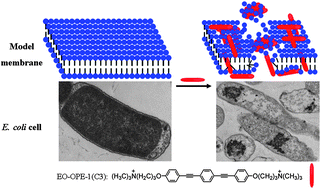Membrane activity of antimicrobial phenylene ethynylene based polymers and oligomers
Abstract
Poly(phenylene ethynylene) (PPE)-based cationic conjugated polyelectrolytes (CPEs) and cationic

* Corresponding authors
a
Department of Chemical and Nuclear Engineering, Center for Biomedical Engineering, University of New Mexico, Albuquerque, NM 87131-1341, USA
E-mail:
evachi@unm.edu, whitten@unm.edu
b Department of Chemistry and Chemical Biology, University of New Mexico, Albuquerque, NM 87131-1341, USA
c
Department of Chemistry, University of Florida, Gainesville, FL 32611-7200, USA
E-mail:
kschanze@chem.ufl.edu
Poly(phenylene ethynylene) (PPE)-based cationic conjugated polyelectrolytes (CPEs) and cationic

 Please wait while we load your content...
Something went wrong. Try again?
Please wait while we load your content...
Something went wrong. Try again?
Y. Wang, E. Y. Chi, K. S. Schanze and D. G. Whitten, Soft Matter, 2012, 8, 8547 DOI: 10.1039/C2SM25238D
To request permission to reproduce material from this article, please go to the Copyright Clearance Center request page.
If you are an author contributing to an RSC publication, you do not need to request permission provided correct acknowledgement is given.
If you are the author of this article, you do not need to request permission to reproduce figures and diagrams provided correct acknowledgement is given. If you want to reproduce the whole article in a third-party publication (excluding your thesis/dissertation for which permission is not required) please go to the Copyright Clearance Center request page.
Read more about how to correctly acknowledge RSC content.
 Fetching data from CrossRef.
Fetching data from CrossRef.
This may take some time to load.
Loading related content
